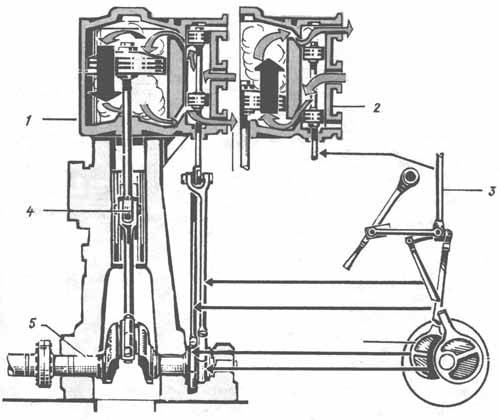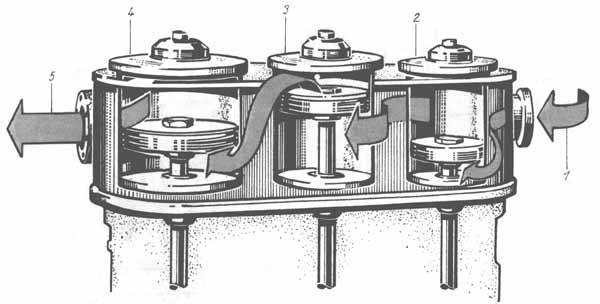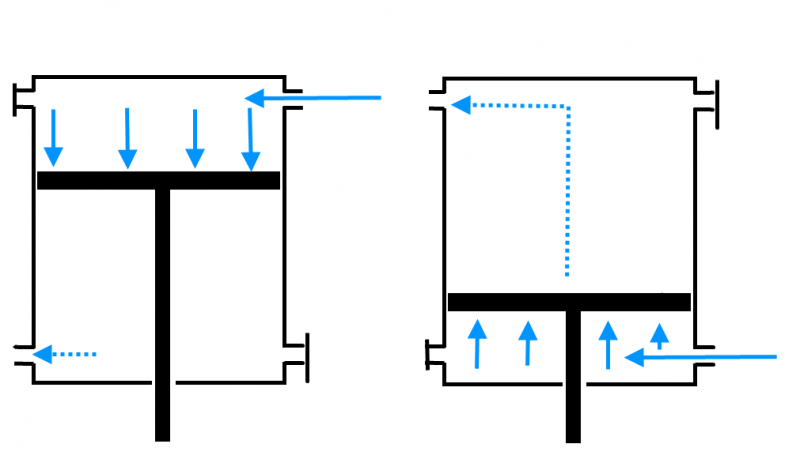The cruiser "Varyag". Fight Chemulpo 27 January 1904 of the Year. Part of 4. Steam engines
In fact, the principle of operation of the steam engine is very simple. There is a cylinder (on ships' machines usually located vertically), inside of which there is a piston that can move up and down. Suppose a piston is located at the top of a cylinder — then steam is pumped into the hole between it and the top cover of the cylinder. The steam expands, pushing the piston down and so it reaches the lowest point. After this, the process is repeated “exactly the opposite” - the upper opening is closed, and steam is now supplied to the lower opening. At the same time, a steam discharge opens on the other side of the cylinder, and while steam pushes the piston up and down, the exhaust steam in the upper part of the cylinder is displaced into the steam discharge (the movement of the exhaust steam is indicated by a dotted blue arrow in the diagram).
Thus, the steam engine provides reciprocating motion of the piston, and in order to convert it into rotation of the propeller shaft, a special device called a crank mechanism, in which the crankshaft plays an important role.

Obviously, to ensure the operation of the steam engine, bearings are urgently needed, due to which the crank mechanism works (the transfer of motion from the piston to the crankshaft) and the fastening of the rotating crankshaft.
It should also be noted that by the time of the design and construction of the Varyag, the whole world in the construction of warships had long ago switched to triple-expansion steam engines. The idea of such a machine arose because the steam that had worked in the cylinder (as shown in the upper diagram) did not lose its energy completely at all and could be reused. Therefore, they did this - first, fresh steam entered the high-pressure cylinder (CVP), but after doing its work it was not “thrown out” back into the boilers, but entered the next cylinder (medium pressure, or CCD) and again pushed the piston inside it. Of course, the pressure of steam entering the second cylinder decreased, which is why the cylinder itself had to be made of a larger diameter than the HPC. But even that was not all - the steam that had worked its way in the second cylinder (CSD) entered the third cylinder, called the low pressure cylinder (LPD), and continued its work already in it.

It goes without saying that the low pressure cylinder should have a maximum diameter in comparison with the other cylinders. The designers did it easier: the low pressure cylinder was too big, so instead of one low pressure shaft, they made two and the cars became four cylinder ones. At the same time, the steam was still supplied simultaneously to both low pressure cylinders, that is, despite the presence of four “expansion” cylinders, three remained.
This short description is enough to understand what was wrong with the steam engines of the cruiser Varyag. And “not so” with them, alas, there was so much of everything that the author of this article finds it difficult to begin with exactly what. Below we describe the main miscalculations made when designing the cruiser steam engines, and try to figure out who, after all, was to blame for them.
So, the problem number XXUMX was that the design of the steam engine, obviously, does not tolerate bending stresses. In other words, good work could be expected only when the steam engine stands on an absolutely level foundation. If this base suddenly begins to bend, then this creates an additional load on the crankshaft, which passes almost the entire length of the steam engine - it begins to bend, the bearings holding it quickly become unusable, there are backlashes and the crankshaft gets displaced, which is why the crank bearings suffer - crank mechanism and even pistons of the cylinder. In order to prevent this from happening, the steam engine must be installed on a solid foundation, but this was not done at Varyag. His steam engines had only a very light foundation and in fact fastened directly to the ship’s hull. And the body, as is well known, “breathes” on the sea wave, that is, it bends during the roll, and these constant bends led to the curvature of the crankshafts and the “rattling” of the bearings of the steam engines.
Who is to blame for this structural defect of “Varyag”? Without a doubt, the responsibility for this ship deficiency should be laid on the engineers of the firm of C. Crump, but ... there are certain nuances.
The fact is that such a design of steam engines (when those without a rigid foundation were installed on the ship hull) was generally accepted - rigid “Askold” and “Bogatyr” did not have rigid foundations, but the steam engines worked flawlessly on them. Why?
Obviously, the deformation of the crankshaft will be the more significant, the greater its length, that is, the greater will be the length of the steam engine itself. There were two steam engines on the Varyag, but the Askold had three. By design, the latter were also triple-expansion four-cylinder steam engines, but at the expense of significantly less power they had a significantly smaller length. Due to this, the impact of the hull deflection on the “Askold” machines turned out to be much weaker - yes, they were, but, let's say, “within reason” and did not lead to deformations that put the steam engines out of operation.
And indeed - initially it was assumed that the total power of the Varyag machines should have been 18 000 hp, respectively, the power of one machine - 9 000 hp But then Charles Crump made a very difficult to explain mistake, namely, he increased the power of steam engines to 20 000 hp. The sources usually explain this by the fact that Charles Crump did it because of the refusal of the MTC to use the forced blast during the cruiser tests. It would be logical if C. Crump simultaneously increased the performance of the boilers in the Varyag project to the same 20 000 hp simultaneously with an increase in the power of the machines, but nothing like that happened. The only reason for such an action could be the hope that the cruisers' boilers would exceed the capacity set by the project, but how could this be done without forcing them?
Here, one of two things already - or Charles Crump still hoped to insist on conducting tests when forcing the boilers and feared that the machines would not “stretch” their increased power, or for some unclear reason he believed that the Varyag boilers and without force reached the power 20 000 hp In any case, the calculations of Charles Krump turned out to be erroneous, but this led to the fact that each cruiser machine had a power of 10 000 hp. In addition to the natural growth of mass, the dimensions of steam engines (length reached 13 m) increased, of course, while three Askold cars, which were supposed to show 19 000 hp. nominal power, should have been just for 6 333 hp each (alas, their length is unfortunately unknown to the author).
But what about "Bogatyr"? After all, he was, like the Varyag, a two-shaft, and each of his cars had almost the same power - 9 750 hp against 10 000 hp, and therefore had similar geometric dimensions. But it should be noted that the housing of the Bogatyr was somewhat wider than that of the Varyag, it had a slightly smaller length / width ratio and in general seemed to be more rigid and less prone to deflection than the housing of the Varyag. In addition, it is possible that the Germans strengthened the foundation with respect to the one on which the Varyag steam engines were stationed, that is, if it was not similar to those of more modern ships, it still provided better strength than the Varyag foundations. However, this question can be answered only after a detailed study of the drawings of both cruisers.
Thus, the fault of the Kramp engineers was not that they had set a weak foundation for the Varyag cars (the rest of the shipbuilders, it seems, did the same), but that they did not see and did not realize the need to ensure “inflexibility "Machines more robust housing or the transition to a three-screw scheme. The fact that a similar problem was successfully solved in Germany, and not only the extremely experienced Vulcan, which built the Bogatyr, but also second-rate and not having experience building large warships according to its own project, Germany, is not in favor of American constructors. However, in fairness it should be noted that the MTC did not control the moment, however, it should be understood that no one before him set the task to monitor every sneeze of Americans, and that was not possible.
But alas, this is only the first and, perhaps, not even the most significant lack of steam engines of the newest Russian cruiser.
Problem # 2, which was apparently the main one, was the flawed design of the Varyag steam engines, which were optimized for the ship’s high speed. In other words, the machines worked well with vapor pressure close to the maximum, otherwise problems started. The fact is that when the vapor pressure dropped below 15,4 atmospheres, the low pressure cylinders ceased to perform their function - the energy of the steam entering them was not enough to drive the piston in the cylinder. Accordingly, on economic moves, a “cart began to drive a horse” —the low-pressure cylinders, instead of helping to rotate the crankshaft, were driven by them themselves. That is, the crankshaft received energy from high and medium pressure cylinders, and spent it not only on the rotation of the screw, but also on ensuring the movement of the pistons in the two low pressure cylinders. It should be understood that the design of the crank mechanism was designed to ensure that it is the cylinder that will set the crankshaft in motion through a piston and a slider, but not vice versa: as a result of such an unexpected and nontrivial use of the crankshaft, he experienced additional stresses not provided by his design, which also led to the failure of the bearings holding it.
In fact, there might not have been a particular problem, but only under one condition - if the design of the machines provided for a mechanism that detaches the crankshaft from the low-pressure cylinders. Then, in all cases of operation with steam pressure below the set, it was enough to “press a button” - and the low-pressure cylinder stopped loading the crankshaft, however such mechanisms were not provided for by the design of the Varyag machines.
Subsequently, engineer I.I. Gippius, who led the assembly and adjustment of the destroyer mechanisms in Port Arthur, carried out a detailed survey of the Varyag cars in 1903 and wrote an entire research paper based on its results, indicated the following:
Obviously, C. Crump is entirely to blame for this lack of the Varyag power plant.
Problem # 3 itself was not particularly serious, but in combination with the above errors, it gave a “cumulative effect”. The fact is that for some time when designing steam engines, the designers did not take into account the inertia of their mechanisms, as a result of which the latter were constantly subjected to excessive stress. However, by the time Varyag was created, the theory of balancing the forces of inertia of machines was studied and spread everywhere. Of course, its use required additional calculations from the manufacturer of the steam engine and created certain difficulties for him, which means that the work in general was more expensive. So, MTK in its requirements, unfortunately, did not indicate the mandatory use of this theory in the design of steam engines, and Charles Crump, apparently, decided to save on this (it’s hard to imagine that he himself, and none of his engineers, had anything about theories did not know). In general, whether under the influence of thirst for profit, or because of the banal incompetence, but the provisions of this theory when creating machines "Varyag" (and, by the way, "Retvisan") were ignored, resulting in inertial forces provided "very unfavorable" (according to I.I. Gippius) effect on medium and low pressure cylinders, contributing to the disruption of the normal operation of machines. Under normal conditions (if the steam engine had been provided with a reliable base and there were no problems with steam distribution) this would not lead to breakdowns, and so ...
The blame for this lack of Varyag steam engines should probably be placed on both Charles C. Krump and MTC, which allowed an unspecified wording of the order.
Problem # 4 was to use a very specific material in the manufacture of bearings for steam engines. For this purpose, phosphorous and manganese bronze were used, which, as far as the author knows, were not widely used in shipbuilding. As a result, the following happened: due to the reasons stated above, the bearings of the Varyag machines quickly failed. They had to be repaired or changed for what was available at hand in Port Arthur, and there, alas, there were no such delights. As a result, the situation arose when the steam engine worked with bearings made of materials of completely different qualities — premature wear of some caused additional stresses in others and all this also contributed to the disruption of the normal operation of the machines.
Strictly speaking, this is probably the only problem whose “authorship” cannot be established. The fact that the suppliers of Charles Crump chose such material could not have caused any negative reaction from anyone - here they were completely in their own right. Assuming the catastrophic state of the Varyag power plant, foreseeing its causes and providing Port Arthur with the necessary materials was clearly beyond human capabilities, and it was hardly possible to supply the necessary bronze grades “just in case” given the huge amount of any materials for the squadron the necessity of which was known precisely, but the needs for which could not be met. Blame the mechanical engineers who carried out the repair of machines "Varyag"? It is unlikely that they had the necessary documentation that would allow them to foresee the consequences of the repairs they are doing, and even if they knew about it, what could they change? They had no other options anyway.
Summing up our analysis of the power plant of the Varyag cruiser, we have to admit that the shortcomings and constructive errors of steam engines and boilers complemented each other superbly. It seems that the boilers of Nikloss and the steam engines made a pest against the cruiser on which they were installed. The danger of boiler accidents forced the crew to establish a reduced vapor pressure (not more than 14 atmospheres), but this created the conditions under which the Varyag steam engines had to quickly become unusable, and ship mechanics could not do anything about it. However, in more detail the consequences of the constructive solutions of the machines and boilers of the Varyag we will consider later when we analyze the results of their operation. Then we will give a final assessment of the cruiser power plant.
Продолжение следует ...
- Andrei from Chelyabinsk
- The cruiser "Varyag". Fight Chemulpo 27 January 1904
The cruiser "Varyag". Fight Chemulpo 27 January 1904 of the Year. Part of 2. But why Crump?
The cruiser "Varyag". Fight Chemulpo 27 January 1904 of the Year. Part of 3. Boilers niklossa

Information